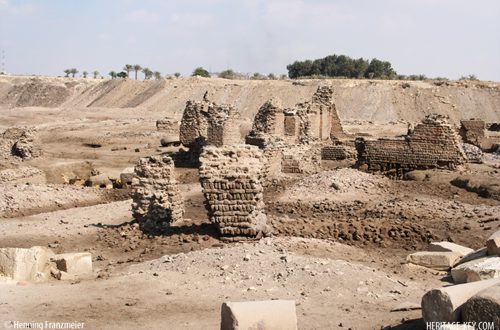 Although there is copious evidence for the Egyptian kings statues, huge depictions on temple walls, stelae the actual reality of the day-to-day work and personal authority of these individuals is often ignored in favour of discussions of divinity, art and ideology. There is good reason for this. Despite the extensive amount of evidence available to scholars, everything is shrouded in a thick layer of ideological presentation that masks the reality of the situation. This makes it difficult to separate fact from fiction: what are we to envision the king did every day?
Although there is copious evidence for the Egyptian kings statues, huge depictions on temple walls, stelae the actual reality of the day-to-day work and personal authority of these individuals is often ignored in favour of discussions of divinity, art and ideology. There is good reason for this. Despite the extensive amount of evidence available to scholars, everything is shrouded in a thick layer of ideological presentation that masks the reality of the situation. This makes it difficult to separate fact from fiction: what are we to envision the king did every day?
Initially, just for fun, it is interesting to see what image is conjured up in your mind when you think of the word Pharaoh. What do you see? Is it a stern-faced man sitting in an alarmingly short kilt with an elaborate crown, being adored and bowed to by subservient followers? Or a warrior king riding on his chariot at the enemy line, firing arrows while steering with the reigns tied around his waist; the army trying to follow behind, but simply unable to keep up? Dont worry if these are your initial thoughts, they are images that have been fostered over a long period of time the image that the Egyptians themselves wanted to present and television has played a big part in recent years to reinforce the ancient propaganda.
Approaching the ancient evidence requires a large degree of scepticism and the need to push aside any preconceived notions regarding who the pharaohs were. We are, after all, delving into an alien world familiar yet not. Our only window into this world is the evidence that lies before us, which presents a certain foggy picture rife with distortion. Distortion occurs in many forms: first there is the simple human need to simplify it is impossible to describe all aspects of everything that ever happens, and so from the beginning the Egyptians are only leaving us a certain fraction of their experience. Next there is conscious distortion, the product of ideological manipulation. The vast majority of textual sources available to us are subject to decorum the rules that regulate how an image could be presented and what a text could say in any particular context. Evidence relating to the king, unsurprisingly, is the most affected by this.
As defender of maat the Egyptian sense of order the king must be presented performing any action that continues this stability: he offers to the gods, he kills all enemies, he leads the army, he widens the borders of Egypt. He does this personally. Things must continue as they always have. This is quite clear in art, and it is the same in texts. In order to strip away these layers of ideology we must approach the texts with issues of genre, theme and context in mind. Context because the location of a text will give away why the information was recorded in the first place, and genre and theme in order to understand what information is being manipulated.
Egyptologists have identified many of the key themes that emerge in textual sources, and it is also possible to see switches in genre within individual texts. The scribes who composed these texts did have accurate records available these are known as daybooks, and record the date, name of the king, and important details required by the administration in a plain straightforward manner. If it was the daybook of the royal palace, it would also record the location of the king, his movements and activities.
Such daybooks formed the core of many royal inscriptions, which could be stored in the palace archive, and their original content can often be deduced from the official publications. Sometimes the same basic administrative record could be used by different scribes to produce different recreations of events.
Amenhotep II of the 18th Dynasty commissioned two stelae to record the events of his military campaigns into the Levant one would be placed at Karnak Temple in the south, and the other probably in a Temple at Memphis in the north (this stele was found re-used in a later tomb in the region). Both were thus religiously motivated. Seemingly the same daybook information was sent to the scribes in the north and south, but they did not work together on their compositions. Both stelae relate the same basic events, except in cases of royal valour when the scribes followed set themes to portray the king in the best possible light (normally at the expense of the army). Whilst crossing the Orontes river, the Memphis stele describes how the king saved his army by chasing down the enemy and killing them all with his arrows; the Karnak edition, however, simply records that he chased down the attackers and killed the enemy commander with his battle-axe, while the rest of the troops fled.
Such descriptions follow exactly the depictions of the king in battle. The narrative switch from plain record of events to ideologically motivated fiction the raging king, majestically attacking the enemy alone – is motivated by the need to show the king as defender of maat, controlling the chaos of the battle, while protecting the people of Egypt here represented by his army.

What then was the kings true role as warrior on the battlefield? If all evidence relating to the king is inherently biased will he forever remain an ever present yet elusive figure? Regarding military texts, at least, if we strip away the ideological flourishes and simply try to recreate the original daybook entries from which the text was composed we are left with very little information to solve this problem. The evidence becomes neutral as to whether the king personally fought with his troops it wont allow us to say whether he did or not. We have to look elsewhere to tip the balance of probability.
For example, there is only one royal mummy that shows any sign of battlefield injury and there is always the possibility that he was assassinated in the palace. None of the great warrior pharaohs of the 18th Dynasty, such as Amenhotep II, show any trace of wounds or injury. In fact, the great warrior Ahmose, who is described as liberating Egypt from the Hyksos invaders, is described by one scholar as delicately built, and probably unable to be a front-line war leader. There are also references to the kings bodyguard in some textual sources, and also to his protection when travelling in Egypt.
Ignoring the ideological presentation of the king, and viewing this evidence objectively, does this not tip the balance of probability in favour of the kings not personally fighting, but having to be presented so for religious reasons? Firm evidence as to the reality of the situation may forever elude us, but sometimes there are hints at what may lie behind the shroud of ideology.



